Fighting a goose invasion with guns, knives and forks
- Published
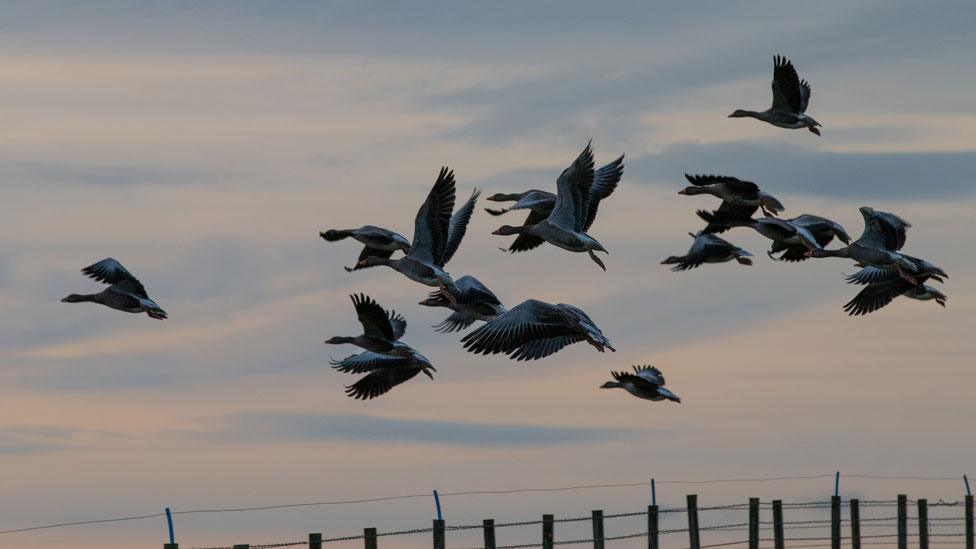
Orkney has been invaded by geese. The numbers are now so huge, and the damage so great, that permission has been granted for the wild birds to be shot - and eaten, reports the BBC's Emma Jane Kirby.
In most situations it would be deemed unwise to tramp across a farmer's fields in the wee small hours dressed in camouflage gear while carrying weapons, but Steve Rogers marches confidently across the frozen grass of Stromness, Orkney, frosted blades snapping and icy puddles splintering under his combat boots, as we approach a saltwater loch where we can hear the faint honking of resident geese.
"I'll get the hide up first," whispers Steve into the darkness as he plonks a rolled-up grille intricately laced with reeds onto the ground and unwinds it.
"Then I'll set some decoys so they'll think their little friends are already feeding." He smiles at the two men following him. "You boys get your guns ready."
In 2002, according to RSPB figures, there were just 300 breeding pairs of greylag geese in Orkney. Six years later that number had increased to a startling 10,000. Fast forward to today and the resident goose population - and no-one knows quite why - has soared to 23,000. That's an awful lot of beaks and big webbed feet trampling grass and eating crops.
"The damage they do in a short space of time is unbelievable," says Steve, who runs Orkney Shooting Holidays, as he prepares to call the geese with his whistle in the first light of dawn. "What we're doing isn't really a sport any more, it's a necessity."
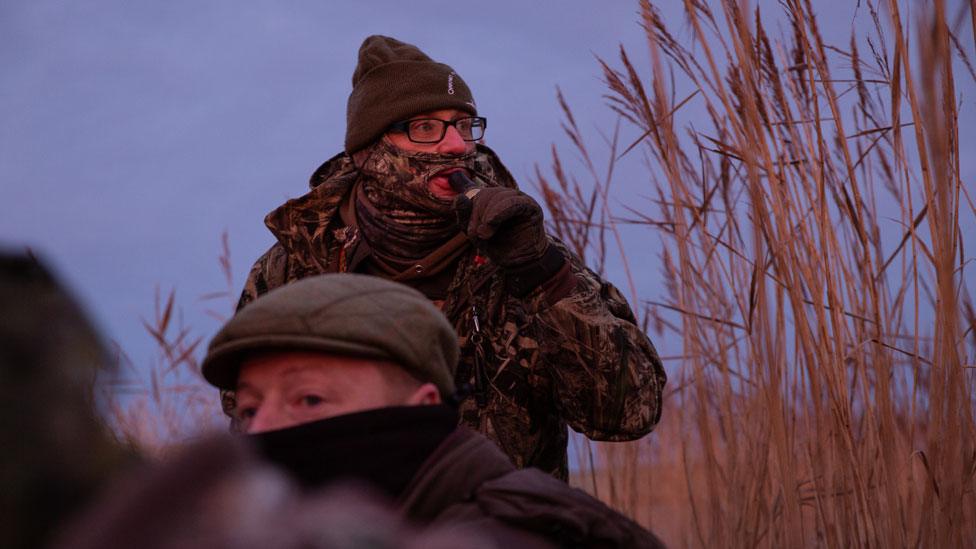
And it's also perfectly legal. Islanders have been allowed to control a set number of the birds since 2012, but the economic and environmental impact of goose grazing is now so serious for crofters that Scottish Natural Heritage (SNH), the body charged with protecting Scotland's wildlife, gave its backing to a larger cull.
"Coming over on the left!" Steve stage-whispers to his two clients crouching inside the hide. "Get 'em, boys!"
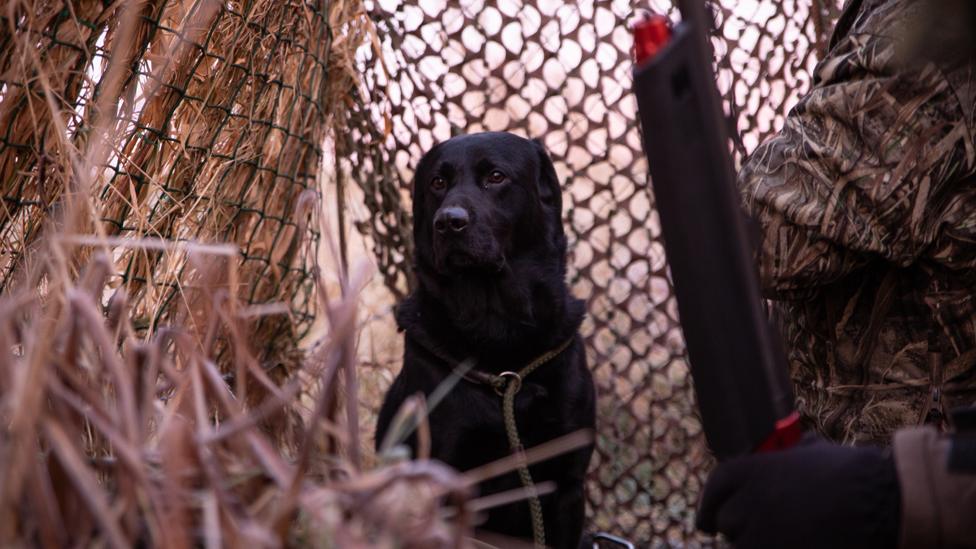
The guns crack out a flurry of shots and Steve releases his Labrador, Jack, who races out to retrieve the fallen birds, darting in and out of the plastic decoys, searching for the casualties. His tail thumps proudly against the reed-camouflaged screen as he carries in the last goose and dumps it in front of his master. Four large, and very dead, greylag geese now share our small hide.
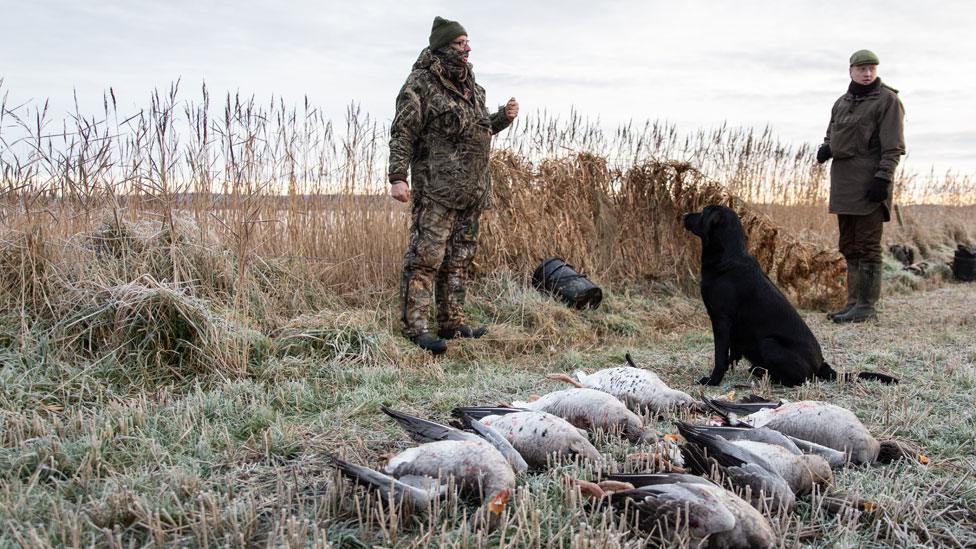
"They ruin my barley!" complains Alister Donaldson, the farmer whose land we are shooting on.
"They're a major problem," he continues, shoving back his woollen hat on his head irritably. "They go for the barley at harvest time, just before it's ready, and they pluck out the young grass and they ruin it. There are that many of them trampling, they soon make a dent on the grass, the crops."
He nods towards Steve and his two shooters, who are checking their guns.
"The numbers aren't dropping fast enough. We need more of these, we need more shooters."
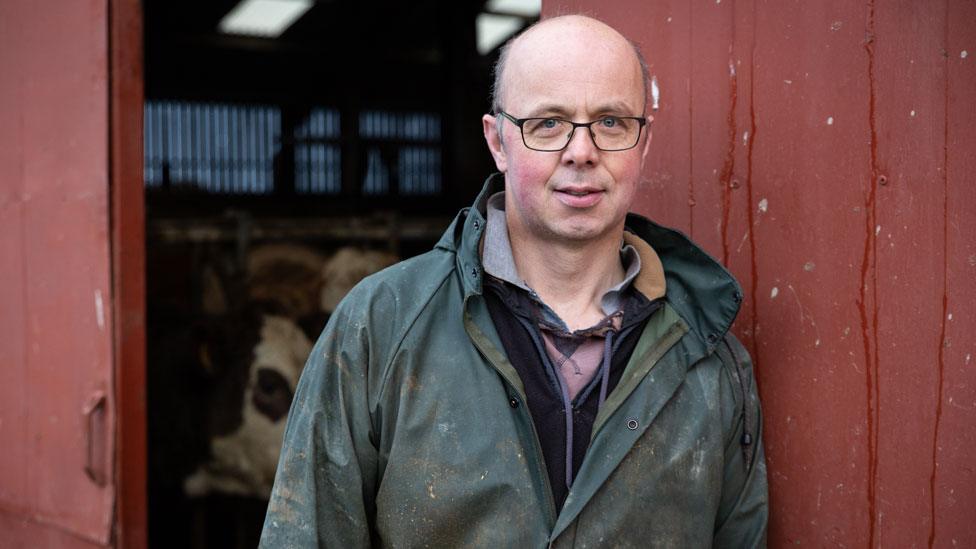
The geese are a major problem for farmers like Alister Donaldson
Greylag geese are a "quarry species", meaning they are a species of least concern - not endangered, threatened or vulnerable. Graham Neville, Scottish Natural Heritage's Northern Isles and North Highland area manager, says SNH's policy towards the geese is about finding sustainable solutions while still fulfilling its nature conservation obligations.
One option being considered is egg-oiling, where eggs are coated in paraffin oil. This deprives the fertilised egg of oxygen and prevents chicks from developing.
Another is a more readily available hunting licence which would allow the shooting of the greylag geese all year round, not just during the shooting season.
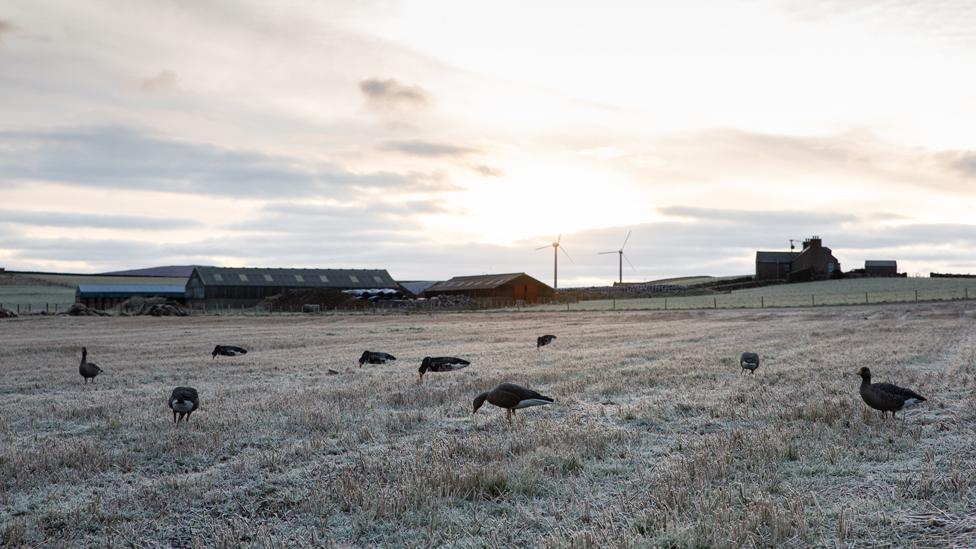
In Steve's hide, where the temperature has spiked upwards to a spiteful -3C, the shooters pass round a flask of scalding, sweet coffee as they wait for the next skein of geese to lift off the lake and fly towards the decoys in the field. Jack whines impatiently, his wagging tail ruffling the dead goose feathers, desperate to be released back into the field. When he sees the shooters take aim, he shivers with excitement.
"Here comes my burger," laughs Rob, one of the shooters, as Steve sounds his whistle.
"And here are my sausages," jokes his friend Paul, as he fires his gun.

Find out more
Listen to Emma Jane Kirby's report on the World at One, on BBC Radio 4

Until recently, most of the culled geese used to be sent to landfill, with only a few licensed Orkney butchers selling the meat to locals.
Now Scottish Natural Heritage has announced a trial project - to be reviewed at the end of January - which allows the butchers to sell the meat across Scotland.
"We're looking at whether we can increase the market for goose meat," says SNH's Graham Neville. "Because then that would allow farmers to actually make money from the goose population, and perhaps creating a market would allow for the long-term funding of goose management."
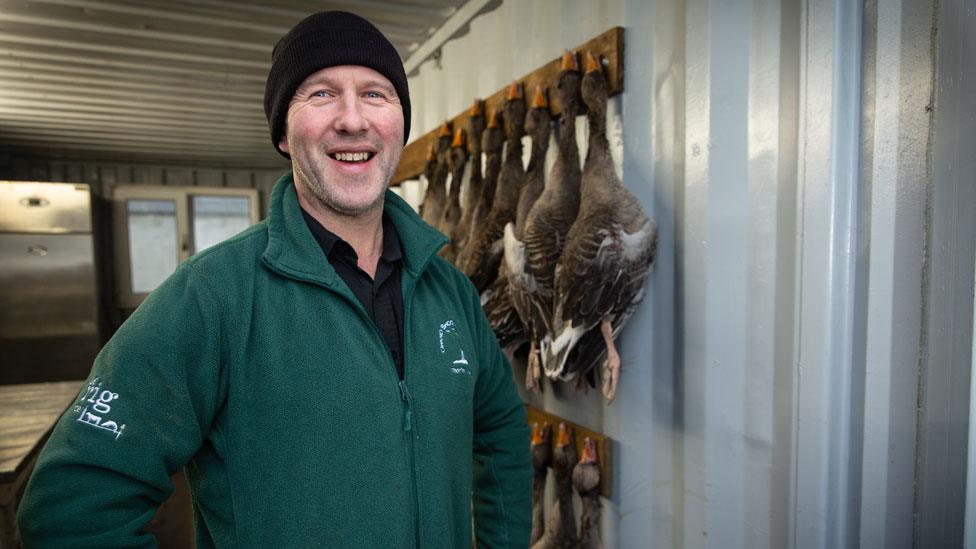
Butcher Thorfinn Craigie is offering goose to his customers
In butcher Thorfinn Craigie's workshop, the back wall is plastered with the carcasses of shot geese, pinned to the wall through the beak. He laughs heartily when I suggest he's got Christmas covered.
"I've already three customers saying they want goose for their Christmas dinner," he grins. "It's the novelty factor," he tells me as he sharpens his knife to prepare a bird for a client who wants an "oven-ready" goose. "Folk like to try new things and when they realise that goose meat is lean and full of protein and really good, well…"
He looks down thoughtfully at the naked, plucked bird on his stainless-steel butcher's trolley.
"We sell a lot of goose burgers and sausages because folk like fast food, but we can sell the meat on now to bars and restaurants across mainland Scotland, even to Glasgow and Edinburgh, and that's great."
His eyes wander across the back wall as he mentally selects his next bird for plucking.
"Nothing gets wasted," he says. "Nobody's wasting anything here, everything's used now and that's what we like."

At the hide, where the geese, alerted to the danger, are making themselves scarce, Steve calls time on the shoot and drives his clients back to the hotel to defrost. There's good-natured banter over the breakfast table as the rival shooting parties rib each other over their prowess and performance.
"The thing is," says Paul, between mouthfuls of bacon, "I justify this in my own mind and I couldn't justify it otherwise, because everything we hit goes into the pot, back on to the table and into the food chain. If it was just mad killing birds, then no. Definitely not. But with the damage the birds cause farmers, well, we're part of the conservation plan really."
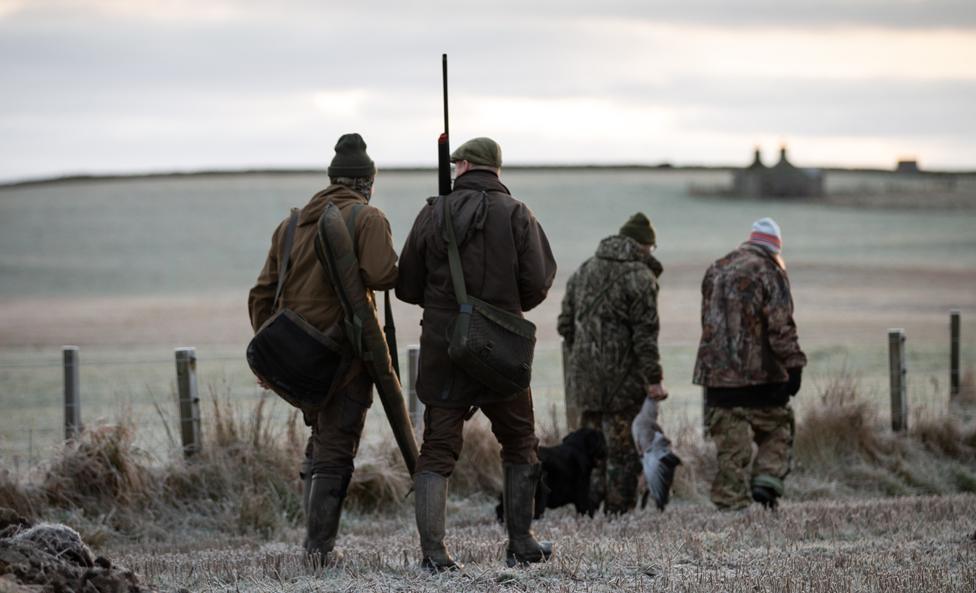
Steve Rogers doesn't have time for breakfast. He's still driving around the island, looking for good goose-heavy spots to take his clients for their afternoon shoot. He's hoping the wind will pick up later to encourage more geese to lift off the water.
"Once the summer trade is gone, you know, there's very little on the island for the hotels and restaurants, and this does bring in a lot of revenue for them," he tells me.
We watch an owl swoop leisurely into the field, hunting its own breakfast.
"My clients are mainly British," he adds. "But we're also now getting French, Maltese and even Russian guys coming to shoot. It's good for tourism."
He looks at his watch and calculates the distance back to Paul and Rob's hotel. There's just enough time to take the eight goose carcasses that are now lying in his car boot to meet Thorfinn Craigie.
Photography by Fionn McArthur, Start Point Media